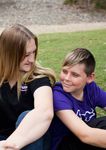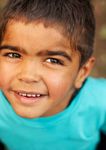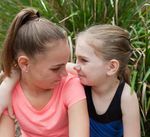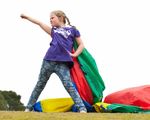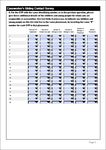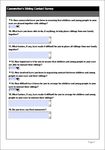SIBLING PLACEMENT AND CONTACT IN OUT-OF-HOME CARE - DR JOSEPH J. MCDOWALL EXECUTIVE DIRECTOR (RESEARCH) CREATE FOUNDATION
←
→
Page content transcription
If your browser does not render page correctly, please read the page content below
Sibling Placement
and Contact in
Out-of-Home Care
Dr Joseph J. McDowall
Executive Director (Research)
CREATE
Sibling Placement and ContactFoundation
in Out-of-Home Care 1Recommended Citation McDowall, J. J. (2015). Sibling placement and contact in out-of-home care. Sydney: CREATE Foundation. CREATE Foundation CREATE Foundation is the national peak consumer body for children and young people with an out-of- home care experience. We represent the voices of over 40,000 children and young people currently in care, and those who have transitioned from care up to the age of 25. Our vision is that all children and young people with a care experience reach their full potential. Our mission is to create a better life for children and young people in care. To do this we; • Connect children and young people to each other, CREATE and their community to • Empower young people to build self-confidence, self-esteem and skills that enable them to have a voice and be heard to • Change the care system, in consultation with children and young people, through advocacy to improve policies, practices and services, and increase community awareness. We achieve our mission by facilitating a variety of programs and services for children and young people in care and developing policy and research to advocate for a better care system. For more information on how to support CREATE Foundation programs and research projects visit www.create.org.au or email create@create.org.au. CREATE Foundation Limited ABN: 69 088 075 058 National Office Level 3, 630 George Street SYDNEY NSW 2000 Tel: (02) 9267 1999 Email: create@create.org.au www.create.org.au Contact CREATE Foundation in your State or Territory on 1800 655 105 Published by the Policy and Advocacy Unit, CREATE Foundation. A pdf version of the document can be downloaded from: www.create.org.au/publications Additional hard copies can be ordered please email create@create.org.au to place your order.
CONTENTS 1.0 Introduction
1.1
1.1.1
The Importance of Family
Families as Systems
4
4
4
1.1.2 Theoretical Perspectives 7
1.1.3 Siblings in the Family Unit 8
1.2 The Out-of-Home Care Experience 12
1.2.1 Background of Children in
Out-of-Home Care 13
1.2.2 Sibling Relationships in OOHC 14
1.3 Practice Implications 20
1.3.1 Programs to Enhance Sibling
Relationships 20
1.3.2 Implications of Case
Management 21
1.4 Current Study 22
2.0 Method 24
2.1 Sibling Study 24
2.1.1 Participants 24
2.1.2 Materials 26
2.1.3 Procedure 27
2.2 Caseworker Study 28
2.2.1 Participants 28
2.2.2 Materials 29
2.2.3 Procedure 29
3.0 Results 30
3.1 Sibling Placements: Children
and Young People 30
3.1.1 Sibling Placements:
Demographic Factors 30
3.1.2 Sibling Placement and Stability 33
3.1.3 Sibling Placement, Household
Size and Reunification 34
3.1.4 Sibling Placement and Contact
with Family 34
3.1.5 Support for Family Contact in
Sibling Placements 36
3.1.6 Indigenous Sibling Placement
and Connection with Culture 39
3.2 Sibling Placements: Caseworkers 40
3.2.1 Sibling Placements: Case
Demographics 40
3.2.2 Sibling Placements:
Caseworker Records 42
3.2.3 Caseworker Engagement
with Sibling Placement 46
3.2.4 Caseworkers’ Views
Regarding Sibling Contact 484.0 Discussion 54 List of Figures
4.1 Children and Young People’s Figure 1 Distribution of Together, Splintered,
Views on Sibling Placement 54 and Split placement of siblings within
Jurisdictions in Australia as reported by
4.1.1 Sibling Placement and Jurisdiction 54 children and young people in out-of-
4.1.2 Sibling Placement and home care 31
Demographic Factors 55 Figure 2 Distribution of Together, Splintered, and
4.1.3 Sibling Placement and Stability 55 Split placement of siblings across Age
4.1.4 Sibling Placement and Groups of respondents 31
Family Contact 56 Figure 3 Distribution of Together, Splintered,
4.1.5 Indigenous Sibling Placement 57 and Split placement of siblings for
4.2 Caseworker Engagement respondents living in a range of Care
Types 32
with Sibling Placement 57
Figure 4 Distribution of Together, Splintered, and
4.2.1 Caseworkers’ Success in Split placement of siblings for respondents
Placing Siblings 57 with or without a disability 33
4.2.2 Caseworkers and Figure 5 Mean frequency of contact with
Sibling Contact 58 designated family members by
4.3 Conclusion 58 respondents in Together, Splintered,
Split, and Alone (only one in care)
5.0 References 59 placements
Figure 6 Percentage of respondents in the four
35
6.0 Appendices 68 Sibling Placement conditions who had
no contact at all with the designated
APPENDIX A Sibling Placement Survey 69 Family Members 36
APPENDIX B Caseworker Survey 71 Figure 7 Level of support provided by Carers
and Caseworkers for maintaining
List of Tables: contact with family members as
perceived by respondents in the four
Table 1.1 Summary of Relation Types
Sibling Placement conditions 37
Currently Classified as Family 5
Figure 8 Mean Time in Care (in years)
Table 1.2 Comparisons of the Three Family
experienced by children and young
Typologies on Seven Defining Variables 6
people included in this study across
Table 1.3 Operationalization of the Two Poles of Australian jurisdictions 40
the Revealed Themes 20
Figure 9 Mean length of Time caseworkers
Table 2.1 Distribution of Participants by Age within had been supporting the children
the Australian Jurisdictions 24 and young people who comprised
Table 2.2 Distribution of Participants by Cultural their cases 41
Grouping and Sex 25 Figure 10 Mean rating by caseworkers of the
Table 2.3 Distribution of Participants by Care Type estimated Frequency of Contact they
across Jurisdictions 25 have with the children and young
Table 2.4 Distribution of Disabilities Reported by people they are supporting in care
Participants 26 over a 12-month period 41
Table 2.5 Numbers of Caseworkers Who Attempted Figure 11 Distribution of Together, Splintered, and
and Completed the Survey on Sibling Split placement of siblings within
Placement 28 Jurisdictions in Australia as recorded by
Table 3.1 Percentage of Caseworkers Providing caseworkers 43
High and Low Ratings of Importance, Figure 12 Distribution of Together, Splintered, and
Involvement, and Difficulty of Organizing Split placement of siblings across Age
Sibling Contact 49 Groups as recorded by caseworkers 44
Figure 13 Distribution of Together, Splintered,
and Split placement of siblings across
Cultural Groups as recorded by
caseworkers 45
Figure 14 Distribution of Together, Splintered,
and Split sibling placements based on
caseworker data for children and young
people living in four Care Types 461.0
INTRODUCTION
1.1 The Importance of Family
Throughout history, and in all human cultures, the family has been acknowledged as one of the essential
social institutions. Indeed, as Alesina and Giuliano (2013) argue, “there is hardly an aspect of a society’s life
that is not affected by the family” (p.1). Families can provide resources, social support, quality interactions and
relationships, and an emotional climate and stability essential for effective socialization of children (Grusec,
2011). Callan (2014, p. 2) emphasized that family cohesion “can facilitate key processes contributing to wider
social cohesion, such as the development of a moral disposition or ‘character’; the provision of mutual support
and care; and the generation of a sense of personal and group identity.”
Overwhelmingly, it is recognised that the family’s great strength is in providing enduring support to its members
that can lead to their increased wellbeing (Thoits, 2011), in spite of strong family ties being associated with more
parochial attitudes and behaviour (e.g., less interest in political activities and a greater belief in regulations and
a welfare system that enhance family values; Alesina & Giuliano, 2013). In her recent review, Lisa Newland (2014)
concluded, “family well-being (FWB) is one of the strongest and most consistent predictors of child well-being
and resilience” (p. 1).
While most recent research has focused on the family and individuals’ wellbeing in Western society (Peterson &
Bush, 2013), cross-cultural investigations also have highlighted the universality of the connection between family
support and wellbeing. For example, Brannan, Biswas-Diener, Mohr, Mortazavi, and Stein (2013), when comparing
measures such as affective response and satisfaction with life in Middle Eastern cultures including Iran and
Jordan and in the United States, found that family relations was a more consistent predictor of wellbeing than
friendships in all countries studied.
The family in its idealized form constitutes what Biglan, Flay, Embry, and Sandler (2012) classified as a “nurturing
environment”. These are contexts in which agents function by “minimizing aversiveness, reinforcing prosocial
behavior, monitoring and setting limits, and promoting psychological flexibility?” (p. 267). Cox (2006) expressed
his views of what qualities marked strong, effective families using more applied (but similar) descriptors. He
believed their members usually demonstrate: (a) commitment, (b) appreciation, (c) good communication
patterns, (d) desire to spend time together, (e) a strong value system, (f) an ability to deal with crises and stress
in a positive manner, (g) resilience, and (h) self-efficacy. Unfortunately, such characteristics are not found in all
families.
1.1.1 Families as Systems
An important point to note when considering families is that the positive qualities outlined above are not limited
in their expression to any particular type of familial arrangement. As is being widely recognised, the “nuclear
ideal” can no longer be seen as the only acceptable model for family life (Cutas & Chan, 2012). “Normal” as a
concept is now more difficult than ever to apply to family form and function. As Cherlin (2010) opined, although
6 CREATE Foundationmany people believe they have a clear idea of what constitutes a family, “for a significant minority it is becoming
increasingly difficult to tell where the boundaries of a family unit lie” (p. 415).
Walsh (2012) provided a comprehensive overview of the diversity of relationships between adults and children
that now can be considered as family. She identified current issues that need to be addressed when considering
contemporary families: (a) varied family forms, (b) varied gender roles and relationships, (c) growing cultural
diversity, (d) increasing socioeconomic disparity, and (e) varying and expanded family life course. Parke (2013)
summarised well, at the beginning of his book highlighting the challenges of current family diversity, the range of
family types likely to be encountered in contemporary society. This overview is shown in Table 1.1.
Table 1.1
Summary of Relation Types Currently Classified as Family
“Ideal” family form Alternative family forms
Two parents One parent, no parents, or multiple parents
Married Cohabiting, planning to marry, staying single, or divorced
Heterosexual Homosexual, bisexual, nonsexual, transsexual
Two biological parents One or more social parent(s) through artificial insemination, surrogacy, adoption,
foster care, or kinship care
Co-resident Part-time resident, shared custody, visitation access
One (male) breadwinner Dual earner couple, job cycling, “reverse” role family
Child care only by parents Childcare by parents and/or relatives, siblings, staff in child care centres, neighbours,
community child care co-operatives
(Source: Parke, 2013.)
While such blurring of boundaries can lead to difficulties comparing the outcomes for members of these different
groupings, Parke clearly saw great opportunities for additional support and nurturing that the various models
can provide. Broadening the concept of family also has relevance in Australia from a cultural perspective in
that some of the more “diverse” forms from a European viewpoint may be better suited to incorporating the
complexities that exist in Aboriginal family networks (Morphy, 2006).
There now is a compelling body of literature indicating that, in whatever form they may take, families must be
considered as nurturing systems (Unger & Powell, 1991). Member relationships within the unit, and external
connections with the broader community create environments that support and strengthen the family’s ability to
serve as an effective caregiving system. The need for support applies equally to intact or “mainstream” families,
nontraditional families (e.g., foster and adoptive families), and families facing special difficulties, and can
change depending on the stage of the family life cycle. Cox and Paley (1997), in their extensive review of families
as systems, described the family as “an organized whole, with interdependent components and hierarchical
structure,” the influence of which extends across generations and into the external community (Unger, 2011).
Sibling Placement and Contact in Out-of-Home Care 7Parental experience, as well as the literature, supports the observation that the systems experienced by different
family members are rarely the same. Plomin (2011) provided some attempts at answering the difficult question
“Why are children in the same family so different?” The common influences shared by children growing up in
the same family (e.g., their parents’ nature, family activities, their parents’ attitudes and how they interact, their
socioeconomic status, their neighbourhood) are processed and experienced differently by each child. This has
led some workers to look at family socialization from a domain-specific perspective (Grusec & Davidov, 2010),
with the different domains “characterized by a particular form of social interaction between the object and agent
of socialization and by specific socialization mechanisms and outcomes” (p. 687).
Using system theory to guide a longitudinal, observational study of family functioning by studying interactions
between different combinations of family members with an emphasis on outcomes for the children, Sturge-
Apple, Davies, and Cummings (2010) identified three functional types: (a) cohesive, (b) enmeshed, and (c)
disengaged families (see Table 1.2 for defining characteristics of each group). These workers found that
the enmeshed and disengaged experiences had significant impact on the internalizing and externalizing of
behaviours by children in the classroom context. Many of the children and young people in out-of-home care
have had these experiences.
Table 1.2
Comparisons of the Three Family Typologies on Seven Defining Variables
TYPOLOGIES
FAMILY CHARACTERISTICS
Cohesive Enmeshed Disengaged
Interparental hostility Low High Low
Interparental withdrawal Low Low High
Parental emotional availability High High Low
Parental intrusiveness Low High High
Child relatedness High Low Low
Triadic competition Low High Low
Triadic cooperation High Low Low
Triadic cohesiveness High Low Low
(Table derived from results presented by Sturge-Apple, Davies, & Cummings, 2010.)
8 CREATE Foundation1.1.2 Theoretical Perspectives
As well as System Theory (Andreae, 2011), many other perspectives have been adopted when studying sibling
relationships. Whiteman, McHale, and Soli (2011) presented a comprehensive overview of the main theoretical
positions that have been explored in the literature. One of the fundamental theories underpinning work
with families and children is Attachment Theory. The pioneering work of Bowlby (1969, 1988) and Ainsworth
(Ainsworth, Blehar, Waters, & Wall, 1978) in developing this theory has been applied, critiqued, and extended
extensively in the four decades since its formalization. (see Bretherton, 2010, and Freeman, Newland, & Coyl,
2010, for insights into the differences and complementarity of mother–father attachment; Cassidy & Shaver, 2008,
for a recent overview of Attachment Theory; Grossmann, Grossmann, Kindler, & Zimmermann, 2008, and Sroufe,
2005, for discussion of attachment beyond infancy; Slater, 2007, for discussion of the implications of attachment
in an educational context; and Prosada, 2013, and Stevenson-Hinde, Chicot, Shouldice, & Hinde, 2013, for a
detailed exploration of the generality of the sensitivity construct and the sensitivity-security connection as
applied to attachment.)
1.1.2.1 Integrating Attachment and Systems Theory
Researchers with experience in family studies have advocated the integration of System Theory and Attachment
Theory to give a more complete picture of family dynamics. Kozlowska and Hanney (2002) have advocated
adopting a network paradigm in which “dyadic, triadic, and family relationships represent distinct system
structures (levels of complexity), with unique laws and properties. Each forms a whole, while simultaneously
constituting a part” (p. 293). Taking this perspective means that researchers and therapists are able to consider
the unique properties of the smallest interacting unit (e.g., the parent–child dyad), together with the unique
properties of the family as a whole, as well as the relationship between them.
Other workers have emphasised the correspondence between the patterns of attachment that have been
identified and the different types of family systems. Various authors (e.g., Byng-Hall, 2008; O’Gorman, 2012;
Rothbaum, Rosen, Ujiie, & Uchida, 2002) have connected the recognized attachment classifications (Ainsworth
et al., 1978; Main & Solomon, 1986) with the family systems categories outlined in Table 1.2. Secure attachment is
usually found in families displaying cohesive (adaptive) qualities, ambivalent attachment in enmeshed families,
and avoidant and disorganized attachment is likely to be encountered in disengaged family systems.
Attachment theory tends to be concerned with family dynamics involving protection, care, and felt security;
family systems theory deals with dynamics involving structures, roles, communication patterns, boundaries,
and power relations. From a therapeutic viewpoint, as Crittenden and Dallos (2009) argued, “attachment theory
addresses the developmental and diagnostic ‘front end’ of dysfunction more thoroughly whereas family systems
theory addresses the complexity of development gone awry and treatment processes” (p. 390). Together, these
theories provide researchers with the capacity to explain many aspects of family relationships, both between
parents and children and between siblings in a family environment.
Sibling Placement and Contact in Out-of-Home Care 91.1.3 Siblings in the Family Unit
Family dynamics depend to a large extent on the number of people in the household and their relationships with
each other. A common arrangement is for children to live with their siblings and adults. However, an unexpected
complexity that arises when dealing with siblings is that a child’s definition of the concept can differ from the
traditional view of what constitutes a brother or sister (i.e., same biological parents). Washington (2007) showed
that imprecise definitions of what constitutes a sibling permeate the literature. As discussed in the Child Welfare
Information Gateway (2013) January Bulletin, there can be many types of relationships that may be perceived as
involving “siblings” (p. 2):
• Full or half-siblings, including any children who were relinquished or removed at birth;
• Step-siblings;
• Adopted children in the same household, not biologically related;
• Children born into the family and their foster/adopted siblings;
• Other close relatives or nonrelatives living in the same kinship home;
• Foster children in the same family;
• Orphanage mates or group-home mates with a close, enduring relationship;
• Children of the partner or former partner of the child’s parent;
• Individuals conceived from the same sperm or egg donor.
The recognition of close, non-biological relationships as a source of support for the child champions family-
centered practice and can be important in respecting cultural values. This broader view of siblings was supported
in recommendations made by the SA Guardian for Children and Young People (2011) following her recent review,
and is reflected in standards being considered internationally. “In these cases, the child may be one of the best
sources of information regarding who is considered a sibling” (Child Welfare Information Gateway, 2013, p. 2).
Official statistics used to determine sibling prevalence generally are derived from “family households” composed
of “two or more persons, one of whom is at least 15 years of age, who are related by blood, marriage (registered
or de facto), adoption, step, or fostering (Weston, Qu, & Baxter, 2013, p. 3). In the UK, the Office for National
Statistics (2011) reported that 27% of all dependent children (those aged under 16, or aged 16 to 18 if in full-time
education) lived in families where they were the only child, indicating that 73% of dependent children must live
with one or more siblings. Kreider and Ellis (2011) claimed a slightly higher percentage in the US where 78%
of children were living with one or more siblings; McHale, Updegraff, and Whiteman (2012) extended this to
82.2% when considering youth aged 18 years and under. By comparison, the numbers as they can be derived in
Australia appear considerably lower at around 54% of children living with siblings, based on the 2011 ABS Census
data, although more precise data directly reporting on sibling numbers would be of value.1
1 ABS Census data reveal that there were 5,684,062 families in Australia at that time. Unpublished data (Weston, Qu, & Baxter, 2013)
indicated that 62.2% of families had two or more children (see Figure 2 of Weston et al.); it follows that 37.8% had only one child, or 2,148,
575 children did not have siblings. If it is estimated that, from the population totals by age, 4,706,344 children 17 years and under resided in
Australia at the census, then 2,557, 769 children (or 54.3%) were living with siblings.
10 CREATE FoundationOver the last 30 years, researchers have become extremely interested in sibling relationships. As well as
acknowledging that these can be long-term connections (possibly the longest relationships those with siblings
will have in life; Dunn, 2000), workers find such relations worthy of study because, given their intimacy and
intensity, the level of familiarity, and the fact that the parents are shared, sibling relationships have potential to
be important influences on children’s wellbeing (Dunn, 2007).
Apart from studies treating sibling characteristics as independent variables, e.g., birth order effects (Bleske-
Rechek & Kelley, 2013); number of siblings (Prime, Pauker, Plamondon, Perlman, & Jenkins, 2014), much
attention has been directed to exploring the nature of the relationship and possible dimensions that may
underlie it including factors affecting the quality of the relationship, how siblings influence each other and the
effects on development and adjustment, cultural differences, and how the relationship changes over time.
1.1.3.1 Nature of sibling relationships
Since the early work of Furman and Buhrmester (1985) who identified four dimensions, the consensus of workers
is that sibling relationships can be described adequately on the basis of three independent factors: affection/
warmth, rivalry/jealousy/ competitiveness, and hostility/aggression (Sanders, 2011). These dimensions have
been used in classic studies to explore the connections with other family members. For example, Stocker and
McHale (1992) asked mothers, fathers, and first and second-born children to rate their family relationships along
these dimensions. One interesting finding concerned differences in relationships with mothers and fathers. While
maternal warmth was negatively related to sibling rivalry and hostility, children who spent more time in father–
child activities and perceived greater warmth in this relationship displayed the most positive and least negative
sibling relationships.
The independence of these factors has been used by others, e.g., McGuire et al. (1996) to categorize sibling
relationships using a two dimensional matrix (Warmth and Hostility). Children in High Hostility/Low Warmth
relationships (“Hostile”) “rated their sibling and parent-child relationships more negatively, and their parents
rated their marriages more negatively” than did those in relationships where Hostility was high but Warmth
was as well (“Affect Intense”) (p. 229). Brody (1998) concluded his review by suggesting that there can be
positive outcomes from an appropriate balance of support and conflict in sibling relationships by providing the
opportunity for children “to develop social-cognitive and behavioral competencies that are linked to managing
conflict and anger on the one hand and providing support and nurturance on the other” (p. 17).
Sibling Placement and Contact in Out-of-Home Care 111.1.3.2 Factors affecting the quality of sibling relationships
Brody’s (1998) study was one of the first major analyses of factors that had been found to contribute to sibling
relationship quality. He identified individual child temperament, marital processes and parental mental health,
parental differential treatment and conflict management strategies as all impacting significantly on interactions
between siblings. Conger, Stocker, and McGuire (2009) extended this list by including such factors as parental
divorce and remarriage, and sibling’s developmental disability as well as specifically addressing foster-care
placement. They also discussed ways in which positive qualities of the sibling relationship might in turn
moderate the effects of stressful life experiences and assist child and family adjustment.
Kramer and Conger (2009), when introducing the papers in a special siblings issue of New Directions for Child
and Adolescent Development, showed that children are able, through social learning, to acquire behaviors,
skills, and attitudes from their siblings, and can use that relationship to develop social understanding and
socio-emotional competencies, both prosocial and aversive. Comparison with a brother or sister can assist
with identity formation and de-identification to emphasize an individual’s uniqueness. Sibling relationships
can provide support and validation, particularly for the younger members, but the unshared experiences and
perceived differential treatment also can generate individual differences. Whiteman, Becerra, and Killoren, (2009),
in that same volume, explored the impact of de-identification and social learning in more detail.
The role of sibling relationships within the family system is complex. Researchers argue (e.g., Tucker & Updegraff,
2009) that the interactive effects of sibling and parent influences must be considered for a full understanding of
this dynamic. However, some evidence suggests that early supportive relations with friends also can positively
impact on sibling connections into adolescence (Kramer & Kowal, 2005). Nuances worthy of further study were
identified by Pike, Coldwell, and Dunn (2005) where they were able to show that, in their study of older (around
8 years of age) and younger siblings (4–6 years), relationship quality was linked to the older siblings’ adjustment
but not to that of the younger. Also, based on parental reports of the sibling relationship, it was the variation
in positive (and not negative) sibling behavior that was associated with individual child adjustment. However,
Tucker, McHale, and Crouter (2008) added another variable to the mix by finding that individuals’ adjustment
scores, particularly in mixed-sex dyads, were moderated by the amount of constructive and unstructured time
siblings spent together.
While considerable attention, both in academic and popular circles, has focused on the outcomes of negative sibling
interactions (Caspi, 2012; Hoffman, Kiecolt, & Edwards, 2005; Safer, 2012), including possible significant long-term
effects of sibling bullying (Bowes, Wolke, Joinson, Lereya, & Lewis, 2014; Tanrikulu & Campbell, 2015), other workers
have concentrated on more positive outcomes. For example, Perlman, Garfinkel, and Turrell (2007) described how
parental mediation in sibling conflict not only reduced the fighting but also provided role modelling for the children.
Kramer (2010, 2011) argued that the focus on conflict as a predominant attribute of sibling relationships is misplaced.
She provided a useful discussion of a range of competencies required for promoting prosocial sibling relationships
including: (a) positive engagement; (b) cohesion; (c) shared experiences to build support; (d) social and emotional
understanding; (e) emotion regulation; (f) behavioural control; (g) forming neutral or positive attributions; (h) conflict
12 CREATE Foundationmanagement; and (i) addressing parental differential treatment practices. Researchers and practitioners need to
incorporate these skills into a more comprehensive framework for understanding sibling relationships that will
“acknowledge the ambivalent nature of normative sibling relationships and contain ingredients that help children at
different developmental levels create successful relationships” (p. 85).
Most research with siblings has concentrated on younger age groups from western societies. However, it is
important to recognize that sibling bonding applies at all ages, and treatment received in a sibling cohort when
young can have implications later in life. As Richmond, Stocker, and Rienks (2005) claimed, there clearly is a
developmental interplay between the sibling context and children’s long-term adjustment. Furthermore, evidence
is mounting (Edward, 2011; McGuire & Shanahan, 2010) that there can be different expectations placed on siblings
in different cultures and diverse contexts that can lead to difficulties when the groups with different experiences
are forced to interact. Edward makes it clear that societies differ in the value they place on the “familial self” as
opposed to individuation, competition compared with cooperation, and the extent to which siblings are involved in
caregiving. Such community-wide variations can lead to significant differences in sibling experience.
1.1.3.3 Training and Intervention
Many workers have realized if the prosocial aspects of the sibling experience can be consolidated and enhanced
through family-based interventions, the outcomes for children in adolescence are likely to be more successful
(see Caspi, 2011). After reviewing a range of intervention strategies, Stormshak, Bullock, and Falkenstein (2009)
concluded that socio-emotional development in children may best be influenced if sibling relationships can be
improved “through family-centered approaches that build prosocial sibling interactions, curtail child behavior
problems, and strengthen parenting” (p. 61). Smith and Ross (2007) and Perlman et al. (2007) found that siblings
were able to display more constructive conflict resolution in their own interactions if their parents had been
trained in the use of appropriate mediation techniques.
Recently, Mark Feinberg and colleagues (Feinberg, Sakuma, Hostetler, & McHale, 2013; Feinberg, Solmeyer et al.,
2013) realized that the sibling relationship could be an acceptable gateway into a family to provide programs
designed to reduce the likelihood of future behavioural difficulties in the young members. Their program
Siblings are Special (SAS) was designed to target “both sibling relationship and parenting mediating processes
in middle childhood to prevent behavior problems in adolescence” (Feinberg, Sakuma et al., p. 97). Their
subsequent evaluation (Feinberg, Solmeyer et al., 2013) demonstrated that the “program enhanced positive
sibling relationships, appropriate strategies for parenting siblings, and child self-control, social competence,
and academic performance” (p. 166) as well as helping to reduce child internalizing problems and maternal
depression. Clearly, early positive sibling experiences can have significant long-term benefits.
Sibling Placement and Contact in Out-of-Home Care 131.2 The Out-of-Home Care Experience
One special family type that is the primary focus of this review concerns households in the out-of-home care
system, that are included in the fourth category of Parke’s (2012) classification (see Table 1.1) that relates to
foster and relative/kinship (home-based) care. Fostered children develop a sense of belonging to their substitute
families. Biehal (2012) identified four types of perceived belonging: “as if” (carers were actual parents), “just like”
(carers were like another set of parents), qualified (child had ambivalent feelings but saw family as permanent)
and provisional (mixed messages from adults lead to uncertainty). These categories were determined by
the influence of a number of factors, including day-to-day family practices in foster families, the actions and
commitment of foster and birth parents, and children’s mental representations of their past and current
experiences in these families. Biehal argued that an important task for social workers is “helping children make
sense of their location between two families and supporting their sense of belonging to their foster families as
well as to their birth families” (p. 15).
In Australia during 2012, according to official statistics (AIHW, 2013), 93% of the 39621 children and young people
in out-of-home care were placed in family households. These data indicate that there were 11,664 available
foster-care households, compared with 12,278 kinship-care locations. Overall, 51% of foster-care households had
two or more children or young people placed there compared with 38% of those households in relative/kinship
care. These are the households where the relationships between the children are of interest and where the
“sibling” connection becomes important.
The difficulties encountered with definitions of “siblings” discussed previously, are exacerbated in this context
because, by the nature of the system, another relationship level can be introduced through the biological children
of the foster or kinship carers. Depending on the duration of placement, these individuals easily can become
considered as part of a displaced child’s sibling network. The unique issues carers’ children face in this situation
have not been widely researched (e.g., Höjer, 2007; Younes & Harp, 2007) but there is some understanding of the
impact the decision to foster can have on their lives. Thompson and McPherson (2011), in a thematic analysis of
the available literature, identified five outcomes likely to be experienced by carers’ children as a consequence of
their entering into this “sibling” relationship. Mostly there were positive gains experienced from fostering including
personal development (becoming better communicators, building greater confidence, having new friends to share
with and to help). However, there were experiences of loss, in terms of family closeness, parental time and attention,
and privacy. Some reported instances of conflict leading to tension and possibly violence; others were more
concerned with the transitions or changes they had experienced (more responsibility, involvement in caregiving,
more knowledge of difficult life experiences, pressure to be a good role model). Carers’ children developed coping
strategies to manage the foster sibling relationship (e.g., handling difficult behaviour; the sadness if a foster child
was moved). The carers’ children tended to display more autonomy, and greater independence, separation, and
individuation.
14 CREATE Foundation1.2.1 Background of Children in Out-of-Home Care
Chambers, Saunders, New, Williams, and Stachurska (2010) described in detail the range of problems likely to be
displayed by children and young people who are taken into out-of-home care. This population has been found to
have significantly higher rates of mental, developmental, behavioural, emotional and physical health problems
than non-fostered children from similar socioeconomic and demographic backgrounds. For example, in the USA,
studies have reported that nearly half of foster children surveyed presented with clinically significant emotional
or behavioural problems, and similarly high rates of disturbance (61%) have been found from studies in South
Australia (Sawyer, Carbone, Searle, & Robinson, 2007). Chambers et al. claimed that nearly all will present with at
least one physical health problem, the majority in their review (50–60%) with more than one, as well as high rates
of developmental delay.
Experiences of disrupted care, parental abuse, and neglect have been associated with this array of negative
symptoms. Tarren-Sweeney (2008) observed that the range of mental health problems among children in care is
exceptional and approaches that of a clinical population. Children in out-of-home care can manifest “complex
psychopathology, characterized by attachment difficulties, relationship insecurity, sexual behaviour, trauma-
related anxiety, conduct problems, defiance, inattention/hyperactivity, and less common problems such as
self-injury and food maintenance” (p. 345). Chambers et al. (2010) also reported that children in out-of-home
care were “more likely to have been exposed to detrimental environmental factors such as adverse prenatal
conditions, family poverty, parental mental illness and parental alcohol/drug abuse” (p. 512).
Such background experiences might be expected to lead to differences in attachment with carers, particularly
when considering related (kinship) compared with foster carers. Interestingly, Cole (2006) when comparing
attachment between infants and both kin and unrelated foster caregivers, found similar percentages of
secure attachment relationships in both kin and unrelated caregiver–infant pairings (67–68%) as had been
found previously in birth and adoptive caregiver–infant dyads. Other studies have supported the finding of no
difference in emotional availability between maltreated children and foster mothers based on the foster mother’s
status as kin or non-kin, even after controlling for child’s age, foster mother’s age, foster mother’s education, and
placement duration (Lawler, 2008). Clearly, attachment with caregivers does not differ depending on where the
care is provided.
1.2.1.1 Entry Into Out-of-Home Care
The process of being removed from one’s family of origin can in itself lead to feelings of rejection, anger, and loss.
Folman (1998) presented an insightful analysis of children’s narratives detailing their experience with a variety of
traumatizing events associated with placement process. Feelings outlined included fear and bewilderment, loss
and abandonment, being unsupported, misunderstood, and helpless. However, even when within the system,
children then can experience changes in carers, and the uncertainty surrounding these transitions between
placements has been associated with difficulties such as disrupted identity development, disturbed attachment
relationships, and poor educational outcomes (Chambers et al., 2010).
Sibling Placement and Contact in Out-of-Home Care 15The immediate situation in which children entering the care system find themselves would, by definition, qualify
as a crisis (Caplan, 1964; Slaikeu, 1990). As described by Regehr (2011), crises are perceived as (a) sudden; (b)
involving individuals who are inadequately prepared to handle the event and whose normal coping methods
fail; (c) time-limited, lasting 1 day to 4 to 6 weeks; (d) having the potential to produce dangerous, self-destructive
or socially unacceptable behavior; and (e) produce feelings of psychological vulnerability, which can potentially
be an opportunity for growth. This sequence mirrors well the narratives describing children’s experiences
on entering care, and can be seen as consistent with emotions and behaviours associated with Bowlby’s
(1973/1998) concept of separation.
These feelings can be exacerbated if in the process of removal from the birth family home, children are separated
from their siblings as well. Heckler (2011) cited early work by Timberlake and Hamlin (1982) in which it was
claimed that breaking up of the sibling group could compound the separation and loss issues that accompany
placement in foster care, precipitating a belief in children that they have “lost a part of themselves” and no
longer can access their usual support systems. These reactions are consistent with the “missingness” reported
by people in the general population who have lost siblings (Clark, Warburton, & Tilse, 2009). If it is understood
that youth in the out-of-home care system are likely to have experienced trauma, and as Moylan et al. (2010) have
indicated, trauma has been associated with internalizing behaviours, then the potential protective nature of a
positive sibling relationship in mitigating the likelihood of mental health problems becomes important (Wojciak,
McWey, & Helfich, 2013).
1.2.2 Sibling Relationships in OOHC
Within the literature on sibling placements, there is an accumulating body of evidence supporting the view
that children’s living with siblings is a desirable state. For example, in 2005, the influential publication Children
and Youth Services Review dedicated a special edition to issues surrounding the placement of siblings in out-of
home care (Shlonsky, Elkins, Bellamy, & Ashare, 2005). Some of the papers in this valuable collection dealt with
largely methodological concerns (identifying sibling groups: Lery, Shaw, & Magruder, 2005; longitudinal analyses:
Wulczyn & Zimmerman, 2005; policy frameworks: Shlonsky, Bellamy, Elkins, & Ashare, 2005). Others were
concerned more with practice issues.
Herrick and Piccus (2005) addressed their contribution in this volume to investigating the ameliorating effect that
sibling connections can have on feelings of anxiety, trauma, grief, guilt and loss of identity children may experience on
entering care. In addition, they were able to show that nurturing sibling bonds not only reduced the impact of some
of the negative occurrences while in care, but also provided a valuable support well into adulthood (see Silverstein &
Smith, 2009, for further discussion of prolonging the sibling relationship). Research by McCormick (2010) has shown
that those individuals who experienced stronger sibling relationships while in care had greater levels of social support,
self-esteem, income, and continuing adult sibling relationships than did those who did not have such childhood
relationships. Furthermore, those alumni with greater access to siblings, and who reported stronger childhood
relationships with siblings, had higher scores on an overall composite outcome measure (based on employment,
education, strength of adult sibling relationship, housing, income, self-esteem, and social support).
16 CREATE Foundation1.2.2.1 Impact of Placement with Siblings
Stability and permanency in placements are more likely to be achieved when siblings are located in the same
placement. Being placed together in care strongly predicts successful reunification (Webster, Shlonsky, Shaw, &
Brookhart, 2005). Brothers and sisters placed completely or partially together reunify at a faster rate than those
placed apart (Albert & King, 2008). This difference increases over time, in particular after the first year in care. If
siblings were placed together, they were less likely to remain in care (during the first 8 months) than were those
placed apart. While Leathers (2005) did not find a relationship between sibling placements and reunification,
she did observe that children who lived with the same number of siblings consistently throughout foster care
were more likely to achieve permanency (be adopted or moved to guardianship orders) than those placed alone.
In addition, it has been found that children placed in intact sibling groups also experienced more stability and
fewer disruptions in care than those who were separated (Drapeau, Simard, Beaudry, & Charbonneau, 2000). In
this Canadian study, children in foster care who were separated from siblings on average had a greater number of
previous placements and they were perceived to have less harmonious relationships with their brothers and sisters
than children in intact sibling groups. It appears that factors such as foster care placement and parental divorce
have a greater impact on the children’s relationships when the sibling group is split than when it is kept intact.
In their exploration of the mental health and socialization of siblings in care, Tarren-Sweeney and Hazell (2005)
observed that, although boys showed no significant differences in measures based on their care status, girls
placed with one or more of their brothers and/or sisters presented with better mental health and socialization
than girls who were separated from their siblings. Hegar (2005), based on a detailed, critical literature review,
noted mixed findings on the impact of separation of siblings possibly due to methodological shortcomings in
many of the studies. However, she felt confident in reporting that joint sibling placements are as stable as, or
more stable than, placements of single children or separated siblings, and that children do as well or better when
placed with siblings.
Hegar and Rosenthal (2009) conducted research into the effect of placement type (kinship vs. regular foster-care)
on outcomes for separated or co-resident children. They analysed carer observations and compared these with
those of teachers. It appeared that kinship carers tended to be less critical than non-kinship foster parents in
that they identified internalizing or externalizing problems in children significantly less often. Teachers, on the
other hand, assessed children in kinship placements as more likely to exhibit externalizing problems. From the
young persons’ perspective, being placed with a sibling was seen as contributing to lower levels of internalizing
problems (e.g., depression, self-blame), while girls placed in kinship care reported lower levels of externalizing
behaviors (e.g., anger, aggression) than did girls placed in foster placements. Of greater relevance here is the fact
that children and young people placed with one or more siblings were more likely than others to feel emotionally
supported, and to feel closer to their caregivers.
Sibling Placement and Contact in Out-of-Home Care 171.2.2.2 Indigenous Young People and Sibling Placement
Given the acknowledged over-representation of Aboriginal and Torres Strait Islander children and young people
in out-of-home care (see AIHW, 2013), the particular relevance of sibling relationships must be considered not
only for continuity of family connections but also for linkage to community and culture. The need for connection
between Indigenous siblings, particularly when placed with different carers, has been recognized for some time,
given the cultural significance of family (Higgins, Bromfield, & Richardson, 2005). In a follow-up report outlining
recorded views of Indigenous young people in care as well as the views of carers of Indigenous young people,
these researchers observed “It would appear that the cultural commitment to community and caring—often
identified as a characteristic of Indigenous culture in Australia—was evident in the sense of responsibility
to family already being experienced by some of the young people in care” (Higgins, Bromfield, Higgins, &
Richardson, 2006, p. 44). This “sense of responsibility” for siblings has been noted in other studies (e.g., Long &
Sephton, 2011).
Moore, Bennett, and McArthur (2007) conducted two youth forums with 52 children and young people of
Aboriginal or Torres Islander descent and during the process asked them to talk about family and siblings. From
the responses received it was clear participants felt that “family provided them with support, with belonging
and often identified family as being the most important thing in their lives” (p.25). Several thought that more
early family support could have prevented their being taken into care. The respondents reported similar views
to other children and young people regarding sibling contact: “they wanted to be placed with their siblings or, at
least, to be able to stay in constant contact during their placement” (p. 27). Older siblings felt a need to support
and protect younger children; the younger ones felt safer with that support. However, a number of young people
reported being disconnected from family and discouraged contact with siblings.
Moss (2009), from her art therapeutic analysis of work by 20 Indigenous children and young people (13 of whom
were in out-of-home care), advocated for recognition of the “pivotal role of family and culture in the child’s
development and the growing literature on keeping siblings together as well as that on the importance of
systems of kinship care” (p. 541). She also made the critical point, from a caseworker’s perspective, that “locating
and supporting such placements is extremely difficult and requires a great deal more effort, time, and support
than a single child placement, and policies emphasizing speedy resolution only intensify the difficulties involved”
(p. 543). It appears that Indigenous children and young people are likely to experience all the common issues in
sibling placement, but to an enhanced degree because of the importance of such relationships in all facets of
their lives.
1.2.2.3 Type of Sibling Grouping
Placement with siblings can lead to a range of positive outcomes for children in the out-of-home care system,
certainly in home-based placements. There also is evidence that children’s wellbeing may be greater in intact
sibling placements even in residential care (Davidson-Arad & Klein, 2011). However, it is clear from the literature
that not all “sibling placements” are equivalent. Practice implications can impact significantly on potential
18 CREATE Foundationbenefits. Linares, Li, Shrout, Brody, and Pettit (2007) studied groups that had different placement histories. Within
their sample of maltreated children, they identified some who had been continuously together in placements,
those who had been continuously apart, and those who had experienced disrupted placement (siblings initially
placed together and then were separated). Siblings in continuous placements (together or apart) did not show
behaviour change. However, siblings in disrupted placement with high initial behavior problems were rated as
having fewer problems at follow-up, while siblings in disrupted placement with low initial behavior problems
were rated as having more problems at follow-up. This possibly could be an example of regression to the mean
(Nesselroade, Stigler, & Baltes, 1980) where high and low extreme scores convert to more moderate values on
subsequent testing. Awareness of this trend could have implications for practice in terms of carer and caseworker
training.
In an attempt to introduce more precision into descriptions of the concept “sibling placement”, Hegar and
Rosenthal (2011) differentiated three types of sibling arrangement: those who lived with all their siblings in
the placement (“together”); those who resided with at least one sibling in their home but another sibling lived
elsewhere (“splintered”); and those children who had no siblings in the home (“split”). Children were asked
about “real” brothers and sisters but the final definition of sibling was left to the child and was as broad as
possible. Overall, no differences were found on any indicator of behavioural problems based on placement
status. However, when comparing kinship with foster-care placements, it was observed that more successful
outcomes were obtained from the splintered and together groups in kinship care than in non-kinship care,
and in kinship care, both the splintered and together groups presented significantly fewer behaviour problems
than did the split group. In addition, teachers reported that superior academic performance was recorded in
the together compared with that in both of the other groups; also fewer instances of problematic internalizing
and externalizing behavior were observed in the splintered and together groups compared with the split group.
Finally, the splintered group showed more closeness to the primary caregiver and a greater liking for the people
in the foster family than did those who had been “split”. It would appear that the presence of at least one co-
resident sibling could have positive outcomes in placements.
1.2.2.4 Keeping Siblings Together in Placements
The apparent weight of evidence supporting the positive effects of joint sibling placement led to the passing of
The Fostering Connections to Success and Increasing Adoptions Act of 2008 in the USA. This legislation provided
“support for relative placement, adoption of special needs children, supporting older children aging out of care,
expanding federal training funds to nonpublic child welfare employees, authorizing tribes to access federal
dollars directly, promoting educational stability, and monitoring health care for foster children” (Gustavsson
& MacEachron, 2010, p. 39). Section 206 of this Act enshrines the basic principles governing sibling placement
that many child protection authorities around the world espouse. Specifically, it requires that child protection
agencies make “reasonable efforts”:
Sibling Placement and Contact in Out-of-Home Care 191. to place siblings removed from their home in the same foster care, kinship guardianship or adoptive
placement, unless the State documents that such a joint placement would be contrary to the safety or well-
being of any of the siblings; and
2. in the case of siblings removed from their home who are not so jointly placed, to provide for frequent
visitation or other ongoing interaction between the siblings, unless that State documents that frequent
visitation or other ongoing interaction would be contrary to the safety or well-being of any of the siblings.
In Australia, similar stipulations exist in various jurisdictions. For example, as part of the Significance of Sibling
Contact report, the SA Guardian for Children and Young People (2011) noted, “there is a paucity of data on sibling
co-placement at a national level. The Australian Institute of Health and Welfare does not collect information
about siblings from states and territories in their reporting in the Child Protection Australia series (Wise 2011)”
(p. 12). However, the Standards of Alternative Care applicable in that state do address sibling placement:
Standard 1.1 directs that ‘where siblings are being assessed and placed, the collective needs of siblings
are considered, as well as the individual needs of each child and young person. Where it is possible, and
appropriate siblings are placed together.
Standard 1.2 requires the caseworker to provide the carer with information about family contact.
(Guardian for Children and Young People, 2011, p. 5)
1.2.2.5 Barriers to Co-Placement
Given these expectations, an important question needing to be addressed is: Under what conditions is it
necessary to separate siblings? Shlonsky, Webster, and Needell (2003) noted that separation was likely at
some stage when children came into care at different times, if sibling groups were large, if the sex of siblings
was not matched, with older children and where the age range of siblings was great, and when placement
was in residential (group) care. Leathers (2005) articulated two key factors that influenced workers’ decisions
to separate siblings in out-of-home care: limited placements willing to accept sibling groups, and behavioural
problems of the children. She also agreed that multiple entries into care over time would increase the chance of
sibling separation.
The Child Welfare Information Gateway (2013) published a useful summary of the barriers likely to preclude the
placing of siblings together, derived from several key research studies. These included the size of sibling group
(larger groups are more often split); the age gap (wide age span leads to splitting); differences in the needs of
siblings; type of placement (siblings placed with kin are more likely to be together and those in group care are
less likely; behavior problems (a sibling with a behavior problem is more likely to be removed); organizational
policies and procedures; and adequacy of placement resources and supports (p. 8).
Sephton and Morgan (2012) identified a number of issues that were of particular importance in sibling placement
with Aboriginal and Torres Strait islander children and young people. From their analysis of 15 cases in the
Victorian Aboriginal Child Care Agency’s (VACCA’s) Permanent Care Program, they pointed to the likelihood of a
20 CREATE FoundationYou can also read
